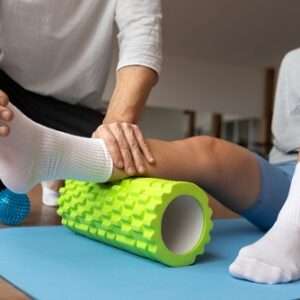Exercise is vital in Physical Therapy, serving as a fundamental component of treatment plans to improve overall Physical function and well-being. Whether recovering from an injury, managing chronic pain, or seeking to enhance performance, Exercise offers numerous benefits to patients under the guidance of a skilled Physical therapist. By incorporating targeted activities into rehabilitation programs, Physical therapists can promote healing, increase strength and flexibility, manage pain, prevent future injuries, and improve cardiovascular health. This multifaceted approach highlights the integral role of Exercise in Physical Therapy, demonstrating its ability to enhance mobility, restore function, and empower individuals to achieve their optimal Physical potential.

Read more: Along with 5 Best Roles Of Exercise In Physical Therapy read more about What Are The Best Aims Of Physiotherapy 2023?
Table of Contents
5 Best Roles of Exercise in Physical Therapy
Exercise is crucial in Physical Therapy as it helps improve mobility, strength, flexibility, and overall body function. Here are five essential Roles of activity in Physical Therapy:

- Rehabilitation: Exercise is a cornerstone of Physical Therapy for rehabilitating injured or impaired individuals. Therapeutic Exercises restore function, range of motion, and strength after an injury, surgery, or illness. By gradually increasing the intensity and complexity of Exercises, Physical therapists help patients regain their Physical abilities and return to normal activities.
- Pain Management: Exercise can be an effective way to manage pain, especially in conditions such as arthritis, chronic back pain, or fibromyalgia. Physical therapists help reduce pain, improve joint mobility, and strengthen supporting muscles through targeted Exercises. Regular Physical activity also promotes the release of endorphins, natural pain-relieving chemicals in the body.
- Improving Strength and Flexibility: Exercise is instrumental in increasing muscle strength and improving flexibility. Physical therapists develop customized Exercise programs focusing on specific muscle groups and targeting areas of weakness. Strengthening Exercises help stabilize joints, enhance balance, and prevent future injuries. Flexibility Exercises, on the other hand, increase the range of motion, reduce muscle tightness, and improve overall flexibility.
- Enhancing Cardiovascular Health: Cardiovascular Exercises, such as walking, swimming, or cycling, are often prescribed by Physical therapists to improve heart health and enhance endurance. These Exercises increase heart rate and circulation, improve lung function, and boost cardiovascular fitness. Cardiovascular Exercises can be tailored to suit the individual’s fitness level, making them accessible to many patients.
- Preventing Future Injuries: Physical therapists also play a crucial role in injury prevention. They assess an individual’s movement patterns, posture, and musculoskeletal system to identify potential areas of weakness or imbalance. By prescribing specific Exercises and providing education on proper body mechanics and ergonomics, Physical therapists help individuals reduce the risk of future injuries and maintain long-term Physical well-being.
It’s important to note that the specific Exercise regimen and approach may vary depending on the individual’s condition, goals, and the guidance of their Physical therapist.
Rehabilitation
Rehabilitation is one of the primary areas where Exercise play s a crucial role in Physical Therapy. Here are the five Best parts of activity in the rehabilitation process:

- Restoring Function: After an injury, surgery, or illness, Exercise is essential in restoring Physical function. Physical therapists design customized Exercise programs tailored to the specific needs of each individual. These Exercises improve range of motion, muscle strength, and joint stability to help patients regain their ability to perform daily activities and tasks.
- Increasing Range of Motion: Exercise is vital in improving and maintaining joint flexibility. Therapists prescribe Exercises that target specific joints and muscles, gradually increasing the range of motion. These Exercises help break down scar tissue, reduce joint stiffness, and enhance flexibility, allowing patients to regain entire joint movement.
- Enhancing Strength and Stability: Rehabilitation Exercises aim to strengthen muscles and improve stability around the affected area. By focusing on specific muscle groups, Physical therapists help patients regain strength, which is crucial for proper movement and joint support. Strengthening Exercises also assist in preventing further injuries by improving overall stability and balance.
- Promoting Healing and Tissue Repair: Exercise stimulates blood flow, delivering oxygen and nutrients to injured tissues, promoting faster healing. Additionally, Exercise triggers the release of growth factors and other biochemicals that support tissue repair and remodelling. Controlled and appropriately dosed activities are essential for promoting optimal healing during the rehabilitation process.
- Improving Coordination and Motor Skills: Rehabilitation often involves retraining movement patterns and improving motor skills. Physical therapists help patients regain coordination, balance, and control over their movements through Exercise. Specific Exercises focus on activities that mimic real-life movements and tasks, allowing individuals to relearn and integrate functional movements into their daily lives.
It is important to note that Exercise programs in rehabilitation are tailored to each individual’s condition, injury, and progress. Physical therapists carefully assess and monitor patients’ Exercise responses to ensure safety, effectiveness, and continuous improvement throughout rehabilitation.
Pain Management
Exercise plays s a significant role in managing pain in Physical Therapy. Here are five of the Best parts of activity in pain management:

- Endorphin Release: Exercise stimulates the release of endorphins, the body’s natural pain-relieving chemicals. Endorphins help reduce pain perception and create a sense of well-being. Regular Exercise can increase endorphin levels, providing natural pain relief and improving overall mood.
- Muscle Strength and Support: Strengthening Exercises prescribed by Physical therapists can help alleviate pain by improving muscle strength and support around the affected area. Strong muscles provide better support to the joints, reducing stress and strain on painful structures. This improved muscular support can alleviate pain and contribute to better overall function.
- Increased Flexibility: Exercises focusing on stretching and increasing flexibility can help manage pain, especially in arthritis or musculoskeletal disorders. Flexibility Exercises help improve joint mobility, reduce muscle tightness, and alleviate pain caused by stiffness and restricted movement.
- Enhanced Joint Stability: Exercise programs designed to improve joint stability can particularly benefit individuals with chronic pain conditions or recurring injuries. Physical therapists use specific Exercises to strengthen the muscles around the joints, enhancing stability and reducing pain. Improved joint stability can also help prevent further damage or worsening pain.
- Distraction and Mood Enhancement: Physical activity distracts from pain and discomfort. By focusing on Exercise, individuals can shift their attention away from pain sensations, leading to temporary pain relief. Additionally, Exercise promotes the release of neurotransmitters and hormones that improve mood and reduce stress, which can positively impact pain perception.
It’s important to note that the type and intensity of Exercises prescribed for pain management will depend on the individual’s condition, pain level, and overall health. Physical therapists work closely with patients to develop personalized Exercise programs that effectively manage pain while considering any limitations or contraindications.
Improving Strength and Flexibility
Exercise play s a vital role in Physical Therapy to improve strength and flexibility. Here are five of the Best parts of activity in enhancing strength and flexibility:

- Muscle Strengthening: Specific Exercises targeting different muscle groups help improve strength and muscle tone. Physical therapists design Exercise programs that progressively challenge muscles, promoting muscle growth and increasing overall strength. Strengthening Exercises are crucial for enhancing functional abilities, preventing injuries, and improving overall Physical performance.
- Joint Stability: Strengthening Exercises increase muscle strength and improve joint stability. Strong muscles surrounding joints provide better support, reducing the risk of joint instability and potential injuries. Increased joint stability allows for better control and movement, contributing to improved overall function.
- Enhancing Flexibility: Exercise programs incorporate stretching Exercises to enhance flexibility. Stretching helps improve the range of motion of joints, muscles, and connective tissues. By increasing flexibility, Physical Therapy Exercises can alleviate muscle tightness, reduce the risk of muscle strains, and improve overall mobility.
- Balance and Coordination: Exercise is crucial in improving balance and coordination, essential for daily activities and preventing falls. Physical therapists incorporate Exercises that challenge balance and proprioception, such as standing on one leg or performing specific movements on unstable surfaces. These Exercises enhance body awareness, stability, and coordination, improving overall function.
- Functional Movement Training: Physical Therapy Exercises often focus on practical movement training, which involves performing Exercises that mimic real-life activities and movements. By incorporating Exercises that simulate daily tasks or sports-specific actions, individuals can improve their strength and flexibility in a way that directly translates to their desired activities or goals.
It’s important to note that Physical therapists assess individuals’ specific needs, capabilities, and goals to design personalized Exercise programs for improving strength and flexibility. The Exercises prescribed will depend on the individual’s condition, the current level of strength and flexibility, and any limitations or contraindications that need to be considered.
Enhancing Cardiovascular Health
Exercise play s a significant role in enhancing cardiovascular health in Physical Therapy. Here are five of the Best parts of activity in improving cardiovascular health:
- Increased Heart Health: Engaging in cardiovascular Exercises, such as walking, cycling, swimming, or aerobics, helps strengthen the heart muscle, improve circulation, and enhance overall cardiovascular function. Regular Exercise promotes a healthy heart by increasing heart rate, improving cardiac output, and lowering resting heart rate. It, in turn, reduces the risk of cardiovascular diseases such as heart attacks, strokes, and high blood pressure.
- Improved Lung Function: Cardiovascular Exercises involve sustained, rhythmic movements that increase breathing rate and lung capacity. These Exercises help improve lung function by strengthening respiratory muscles and enhancing the exchange of oxygen and carbon dioxide in the lungs. Improved lung function allows more efficient oxygen delivery to tissues, enhancing overall Physical performance and endurance.
- Enhanced Endurance: Regular participation in cardiovascular Exercises improves endurance by increasing the body’s capacity to sustain Physical activity over an extended period. Physical therapists prescribe Exercise programs that increase intensity, duration, and frequency, gradually allowing individuals to build endurance. Improved endurance enables individuals to engage in daily activities less fatigued, promoting overall Physical well-being.
- Weight Management: Exercise, particularly cardiovascular Exercise, is effective for managing and maintaining a healthy weight. Physical Therapy Exercises help individuals burn calories, increase metabolism, and build lean muscle mass. Regular Exercise combined with proper nutrition is crucial in weight management, reducing the risk of obesity-related cardiovascular conditions.
- Stress Reduction: Exercise is a natural stress reliever, and it positively impacts mental health. Engaging in cardiovascular Exercises stimulates the release of endorphins, mood-enhancing chemicals in the brain. Regular Exercise helps reduce stress, anxiety, and depression, improving cardiovascular health. Stress reduction is vital as excessive stress can negatively affect heart health and increase the risk of cardiovascular diseases.
Physical therapists work closely with individuals to develop Exercise programs tailored to their specific cardiovascular health needs, considering their fitness levels, any underlying conditions, and overall goals. The type, intensity, and duration of cardiovascular Exercises prescribed will vary depending on the individual’s condition and progress.
Preventing Further Injury
Exercise play s a crucial role in Physical Therapy to prevent further injury. Here are five of the Best parts of activity in injury prevention:
- Strengthening Supporting Muscles: Physical therapists design Exercise programs to target and strengthen the muscles surrounding vulnerable joints or areas prone to injury. By improving the strength and stability of these supporting muscles, individuals can better protect their joints and reduce the risk of damage caused by instability or imbalances.
- Enhancing Joint Stability: Exercise can improve joint stability, reducing the likelihood of injuries such as sprains, strains, or dislocations. Physical Therapy Exercises focus on proprioception and balance training, which help individuals develop better control and awareness of their body’s position in space. Improved joint stability enhances overall movement control and reduces the risk of accidental injuries.
- Correcting Movement Patterns: Physical therapists assess an individual’s movement patterns and identify faulty mechanics or compensations that may increase the risk of injury. Through targeted Exercises, individuals can correct these movement patterns and learn proper body mechanics, reducing stress on vulnerable areas and decreasing the likelihood of future injuries.
- Increasing Flexibility and Range of Motion: Adequate flexibility and range of motion are essential for preventing injuries. Physical therapists incorporate stretching and mobility Exercises to improve flexibility, joint mobility, and muscle elasticity. Enhanced flexibility reduces the strain on muscles and connective tissues during Physical activities, reducing the risk of strains, tears, or other soft tissue injuries.
- Educating on Safe Exercise Techniques: Physical therapists play a vital role in educating individuals on safe Exercise techniques and proper form. By teaching correct posture, alignment, and movement patterns during Exercise, Physical therapists help individuals minimize the risk of injury while maximizing the benefits of Physical activity. This education empowers individuals to Exercise safely, even outside supervised Therapy sessions.
It’s important to note that injury prevention Exercise programs are tailored to the individual’s specific needs, weaknesses, and goals. Physical therapists assess the individual’s condition, analyze risk factors, and develop personalized Exercise plans to address any identified areas of concern and reduce the risk of future injuries.
Summary
To summarize, here are the five Best Roles of Exercise in Physical Therapy:
Rehabilitation: Exercise is a crucial component in the rehabilitation process, helping individuals regain function, range of motion, and strength after an injury, surgery, or illness.
Pain Management: Exercise can effectively manage pain by promoting the release of endorphins, strengthening supporting muscles, and improving joint stability.
Improving Strength and Flexibility: Exercise programs in Physical Therapy target specific muscle groups to enhance strength, stability, and flexibility, promoting better overall function and reducing the risk of future injuries.
Enhancing Cardiovascular Health: Cardiovascular Exercises improve heart health, lung function, endurance, and weight management, reducing the risk of cardiovascular diseases.
Preventing Future Injuries: Physical therapists incorporate Exercises that strengthen supporting muscles, improve joint stability, correct movement patterns, and educate on safe Exercise techniques to avoid injuries.
Exercise in Physical Therapy is tailored to the individual’s specific condition, needs, and goals, ensuring a safe and effective approach to improving Physical function, managing pain, and promoting overall well-being.
Frequently Asked Questions
How does Exercise help in Physical Therapy?
Exercise is crucial in Physical Therapy by improving mobility, strength, flexibility, and overall body function. It helps in rehabilitation, pain management, enhancing stability and flexibility, cardiovascular health, and preventing further injuries.
Can Exercise help in managing pain?
Yes, Exercise can be an effective tool for managing pain. Regular Exercise promotes the release of endorphins, natural pain-relieving chemicals in the body. Additionally, Exercise helps strengthen supporting muscles, improve joint stability, and reduce muscle tightness, all of which can alleviate pain.
How does Exercise improve strength and flexibility?
Exercise programs designed by Physical therapists target specific muscle groups to strengthen them and improve overall strength. Additionally, stretching Exercises enhance flexibility by increasing the range of motion in joints and reducing muscle tightness.
How does Exercise benefit cardiovascular health?
Cardiovascular Exercises, such as walking, cycling, or swimming, improve heart health by strengthening the heart muscle, improving circulation, and reducing the risk of cardiovascular diseases. Regular cardiovascular Exercise improves lung function, increases endurance, and aids in weight management.
How does Exercise prevent further injuries?
Exercise prevents injuries by strengthening supporting muscles and improving joint stability. It also helps correct movement patterns and educates individuals on safe Exercise techniques, reducing the risk of accidents or overuse injuries.
